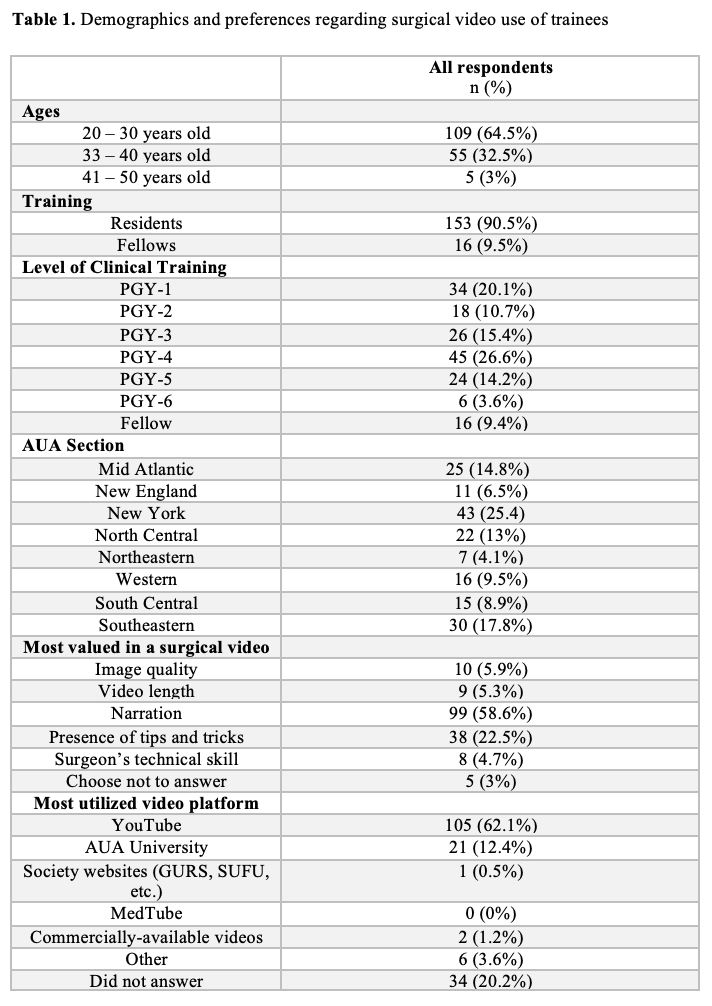Back
Poster, Podium & Video Sessions
Moderated Poster
MP10: Education Research I
MP10-05: Time to Optimize Urology Trainee Education and Preparation for Surgery: Video-Based Surgical Learning
Friday, May 13, 2022
1:00 PM – 2:15 PM
Location: Room 228
Miyad Movassaghi*, Rainjade Chung, New York, NY, Zoe Cohen, New York , NY, Rashed Kosber, Doreen Chung, New York, NY

Miyad Movassaghi, MD, MS
Columbia University
Poster Presenter(s)
Introduction: Surgical education has changed over the last several decades. The benefits of surgical video use, for teaching purposes, has been reported across other specialties. However, little data is available in the urology literature regarding usage patterns, preference and overall satisfaction. Our objective was to identify the most utilized video platforms by urology trainees. Secondary outcomes were to evaluate effectiveness, ease of access, and utility of surgical videos.
Methods: Using an anonymous online survey distributed between Sept – Oct 2021 by the Society of Academic Urology (SAU) to urology residents/fellows in the US, data was collected regarding demographics, frequency and source of surgical videos, helpfulness, ease of access, as well as overall effectiveness in case preparation. Study results were analyzed with descriptive statistics.
Results: Of current trainees surveyed, 169 completed the survey with demographics outlined in Table 1. All reported using videos (for open, robotic, vaginal and endoscopic mostly) with the majority reporting watching 1 (39%) or 2-3 surgical videos (57%) in preparation for cases. 95.3% of trainees report videos as helpful for case preparation. Similarly, 90% report surgical video use as important in their education/training. The most valued video features include ‘narration’ (58.6%) and ‘presence of tips and tricks’ (22.5%). YouTube (YT) (62.1%) and the AUA University (AUAU) (12.4%) are reportedly the most utilized. When stratified by trainee level, nearly all senior residents (PGY4-6) and fellows report using YT, compared to 38% of junior residents (PGY1-3). Comparing the two, 46% of trainees felt it is easy to navigate AUAU, compared to 77% using YT. Nearly 56% of trainees agreed that videos on AUAU help prepare for cases, compared to 87% using YT. Overall, 57% state they would recommend AUAU as a source for surgical videos, compared to 80% of trainees recommending YT.
Conclusions: Although the AUAU contains a repository of surgical videos, most trainees report utilizing YT as the main source for case preparation. The results from our study support the continued use and optimization of surgical video-based learning for the urology trainee. Increasing access to a peer-reviewed video library will be critical in delivering accurate educational content.
Source of Funding: None

Methods: Using an anonymous online survey distributed between Sept – Oct 2021 by the Society of Academic Urology (SAU) to urology residents/fellows in the US, data was collected regarding demographics, frequency and source of surgical videos, helpfulness, ease of access, as well as overall effectiveness in case preparation. Study results were analyzed with descriptive statistics.
Results: Of current trainees surveyed, 169 completed the survey with demographics outlined in Table 1. All reported using videos (for open, robotic, vaginal and endoscopic mostly) with the majority reporting watching 1 (39%) or 2-3 surgical videos (57%) in preparation for cases. 95.3% of trainees report videos as helpful for case preparation. Similarly, 90% report surgical video use as important in their education/training. The most valued video features include ‘narration’ (58.6%) and ‘presence of tips and tricks’ (22.5%). YouTube (YT) (62.1%) and the AUA University (AUAU) (12.4%) are reportedly the most utilized. When stratified by trainee level, nearly all senior residents (PGY4-6) and fellows report using YT, compared to 38% of junior residents (PGY1-3). Comparing the two, 46% of trainees felt it is easy to navigate AUAU, compared to 77% using YT. Nearly 56% of trainees agreed that videos on AUAU help prepare for cases, compared to 87% using YT. Overall, 57% state they would recommend AUAU as a source for surgical videos, compared to 80% of trainees recommending YT.
Conclusions: Although the AUAU contains a repository of surgical videos, most trainees report utilizing YT as the main source for case preparation. The results from our study support the continued use and optimization of surgical video-based learning for the urology trainee. Increasing access to a peer-reviewed video library will be critical in delivering accurate educational content.
Source of Funding: None


.jpg)
.jpg)